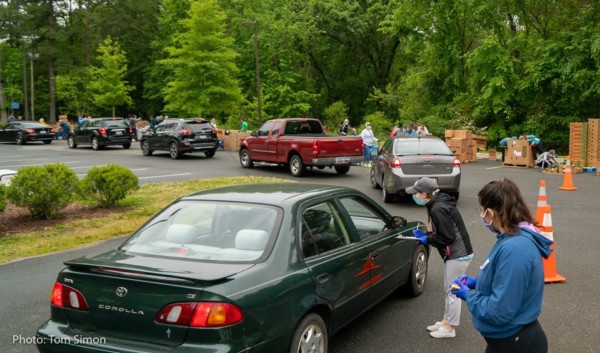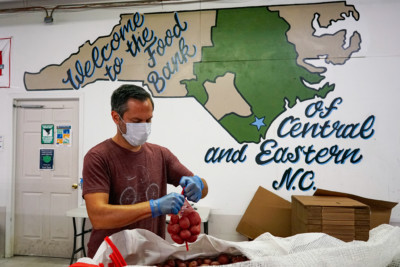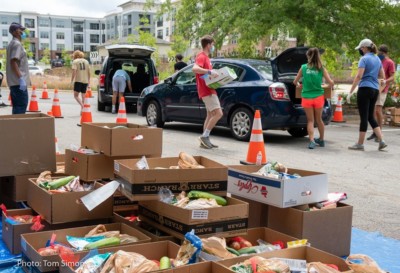Since the beginning of the Food Bank’s response to the COVID-19 pandemic in March of 2020, implementing strategies and adjusting operations for the long-term impact of the pandemic on the community we serve is a top priority. The Food Bank is committed to serving those in need, and we’re very thankful for the trust that’s placed in us.

Find Food
📍 Anyone in our 34-county service area who needs help with food can visit foodbankcenc.org/findhelp and use our Food Finder to search our partner agency network for their local food pantry.
🗺 Live outside our service area? Find your local food bank here.
4 Ways To Help
The work to ensure no one goes hungry continues, and we are more resilient together. We need resources to continue so that we can enact the strategies we know work to end hunger. Here’s how you can help:

Monetary donations allow us to stay nimble, to change our operation as needed, and reach new people with our efforts.

Want to mobilize your neighborhood, church group, or other circle of friends? Holding a Virtual Food Drive is a great way to help – while practicing social distancing.

Research the policies that impact hunger and speak out! Contact your state, local, and federal representatives to let them know policies like SNAP, TEFAP, and WIC need to be strengthened in order to break the cycle of hunger and help relieve families of the burden of hunger. Visit foodbankcenc.org/advocacy or feedingamericaaction.org to learn more.

The Food Bank greatly relies on our volunteers, especially in times of crisis. If you are a healthy adult and want to volunteer, you can self-schedule a shift at foodbankcenc.org/volunteer
“The Food Bank appears to be one of the most effective and efficient non-profit organization that I’ve donated to. I am frequently amazed by your ability to serve the community, particularly during this difficult time.” -Donor
COVID-19 One Year Later
Our quarterly newsletter looked back on a full year of Pandemic Response work. Check it out to see the impact of the support you have shown our community throughout COVID-19.
Meeting The Increased Need
Because of the devastating impact of COVID-19, the Food Bank has seen a staggering increase of approximately 38% in need over the last year, in the 34 counties we serve. This means that approximately 200,000 MORE people didn’t always know where their next meal would come from. In all, more than 750,000 seniors, children, and families were at risk of food insecurity.
Since March of 2020, the Food Bank distributed nearly 159 million pounds of food. This equates to more than 132 million meals. It took an incredible number of resources, support, and partnership to get this done. We’re consistently distributing more food to people in need each month this fiscal year as compared to last. Since the beginning of COVID-19, the Food Bank has spent about 8 times our standard budget in food purchases, to ensure the amount of food going out to the community can remain consistent and increase as we’re able to meet the need of our friends and neighbors.
The COVID-19 economic and health crisis has the greatest negative impact on people and communities who have been marginalized by systemic inequities. It’s laid bare how many members of our community are living one health crisis, one missed paycheck, and one grocery store trip away from needing to use the Food Bank’s pantry network for support with food. We’ve increased our collaboration with organizations that are reaching people who have been marginalized by systemic racism, to listen, learn, and partner in the best way possible.
We’re finding new and innovative ways to implement changes to federal nutrition programs like Kids Summer Meals, SNAP (Supplemental Nutrition Assistance Program), TEFAP (the Emergency Food Assistance Program), and CSFP (Senior Boxes) to serve as many people as possible. Additional staff members have been trained and shifted focus to benefits outreach services to support the large increase in community members seeking federal nutrition benefits like SNAP.
Keeping People Safe & Healthy
The Food Bank and many of our partners are operating in a no-contact fashion, doing drive-thru distributions, home deliveries, and pulling orders of food and loading them outside of our facilities.
The Food Bank has offered vaccine opportunities on-site at our facilities, open to our employees and our partners, and partnering with health organizations to amplify other vaccine clinics.
We’ve been very fortunate to have the support of the North Carolina National Guard, FEMA, and AmeriCorps to keep our operations going and nourish people consistently throughout this crisis.
Volunteering During COVID-19
 Effective August 5, 2021, masks are required at all Food Bank Branches, for all staff, volunteers, and partners. The Food Bank has removed age restrictions on volunteers. In addition, we will begin raising group sizes.
Effective August 5, 2021, masks are required at all Food Bank Branches, for all staff, volunteers, and partners. The Food Bank has removed age restrictions on volunteers. In addition, we will begin raising group sizes.
There is personal protection equipment available at the Food Bank, however if you have these on hand and can bring them, it would allow the Food Bank to conserve those resources. All surfaces are wiped down and sanitized before and after each volunteer session with wipes that contain at least 60% alcohol. We’ve hired additional housekeeping staff to make this possible. We’ve removed focal points like iPad sign in and the name tag station.
All volunteers must wash their hands upon entering the Food Bank, before starting a project. Team members will be on site to direct you to the restrooms. Best practice from the CDC—whether at you’re at the Food Bank or not—wash your hands often with soap and water for at least 20 seconds, especially after going to the bathroom; before eating; and after blowing your nose, coughing, or sneezing. If soap and water are not readily available, use an alcohol-based hand sanitizer with at least 60% alcohol. Always wash hands with soap and water if hands are visibly dirty.
If you are feeling sick, or displaying any symptoms of illness, please stay home. It is true that we rely on volunteer power to get the job done, but we need you to be healthy and operating at 100% to make that happen! Please do not put yourself or anyone else at risk by coming to volunteer when sick. If you are displaying signs of illness while on site at the Food Bank, one of our team members will ask you to return home.
If you sign up and can no longer volunteer, please let our team know so they can fill the empty slot. You can check for any possible changes in your email or this page before coming in for your volunteer session. With your support we can help make sure no one goes hungry during this uncertain time.








